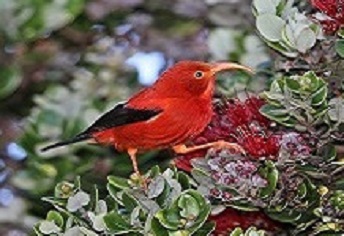Last updated: June 4, 2020
Lesson Plan
Map Analysis

- Grade Level:
- Middle School: Sixth Grade through Eighth Grade
- Subject:
- Science
- Lesson Duration:
- 60 Minutes
- State Standards:
- Hawai‘i Content and Performance Standards III:
SC.8.2.1 - Additional Standards:
- Next Generation Science Standards:
MS-LS2-1 - Thinking Skills:
- Understanding: Understand the main idea of material heard, viewed, or read. Interpret or summarize the ideas in own words. Analyzing: Break down a concept or idea into parts and show the relationships among the parts.
Essential Question
Why is biodiversity important?
What makes biodiversity so unique at Haleakalā National Park?
Objective
At the end of this lesson, the students will be able to determine how Haleakalā National Park protects biological diversity and describe three ways students can help too.
Background
The isolated location of Hawaiʻi, about 2,000 miles from our nearest neighbor, has created the unique plant and animal biodiversity that is found here in the islands. Although isolated, the islands popularity as a visitor destination has brought with it both a number of desirable and undesirable effects. Haleakalā National Park contains designated Wilderness Areas which means that it is “untrammeled” by people. The Wilderness Act of 1964 protects Wilderness Areas from roads, buildings and even too much signage. In Wilderness Areas people are only temporary visitors and are not allowed to permanently live there. The Wilderness Areas within Haleakalā National Park protect much of the remaining biodiversity of Maui’s endemic species.
Preparation
Materials Needed:
Map Analysis Worksheet (included)
Map Analysis Worksheet Teacher Answer Key (included)
Computer with online access (For each group or for individual students) to view the
National Gap Analysis Program Protected Areas Data Viewer
Materials
Map Analysis Worksheet
Download Map Analysis Worksheet
Map Analysis Worksheet Teacher Answer Key
Download Map Analysis Worksheet Teacher Answer Key
Procedure
Step 1: Discuss the geography and biodiversity of the Hawaiian Islands.
Discuss the isolation of the Hawaiian Islands. Hawaiʻi is about 2,000 miles from the nearest land. This isolation has created the unique plant and animal biodiversity that is found here in the islands. Review that biodiversity is the variety of organisms in an ecosystem.
Step 2: National Gap Analysis Program (GAP) Protected Areas Data Viewer
Ask students to access the National Gap Analysis Program (GAP) Protected Areas Data Viewer.
If students do not have individual online access, they can work in small groups or use ELMO.
Step 3: Hand out the Map Analysis Worksheet
Ask students to follow the instructions on the worksheet and complete the questions.
Step 4: Review National Park Service and introduce idea of Wilderness.
Discuss what a Wilderness area and its importance/significance.
Step 5: Discussion and journal activity
- Discuss their predictions on the effects that elevation has on biodiversity in the park.
- Remind them what the highest and lowest elevations are.
- Think of how many different ecosystems might exist in this range of elevations = coastal, rainforest, dry forests, sub-alpine desert, etc.
Ask students to answer the following questions in their journal:
- Predict ways that Haleakalā National Park protects biodiversity.
- How you could help the park protect the biodiversity of Maui?
Vocabulary
Biodiversity: The variety of organisms in a specific environment.
Species: A group of similar individuals that can usually breed among themselves and produce fertile offspring.
